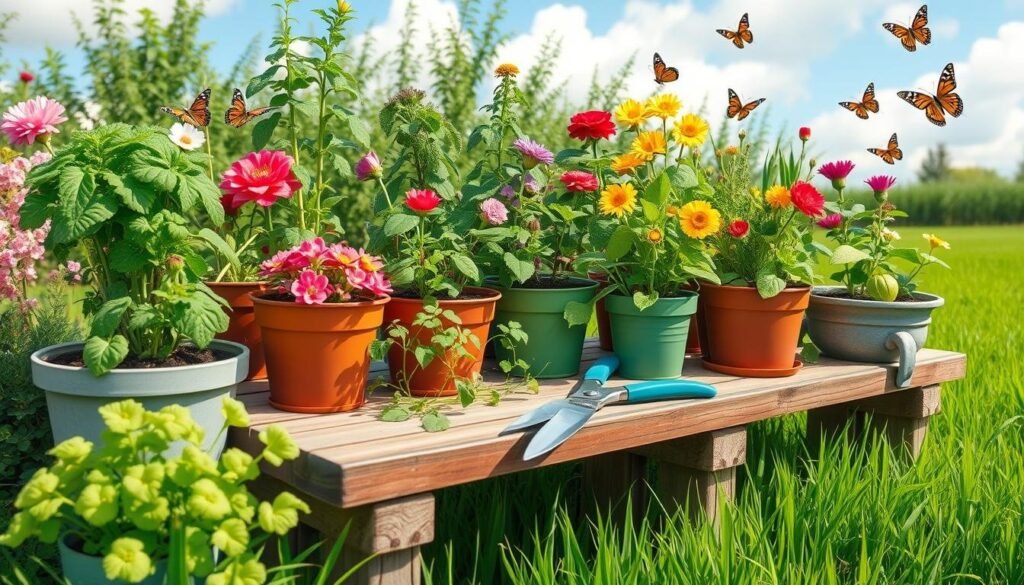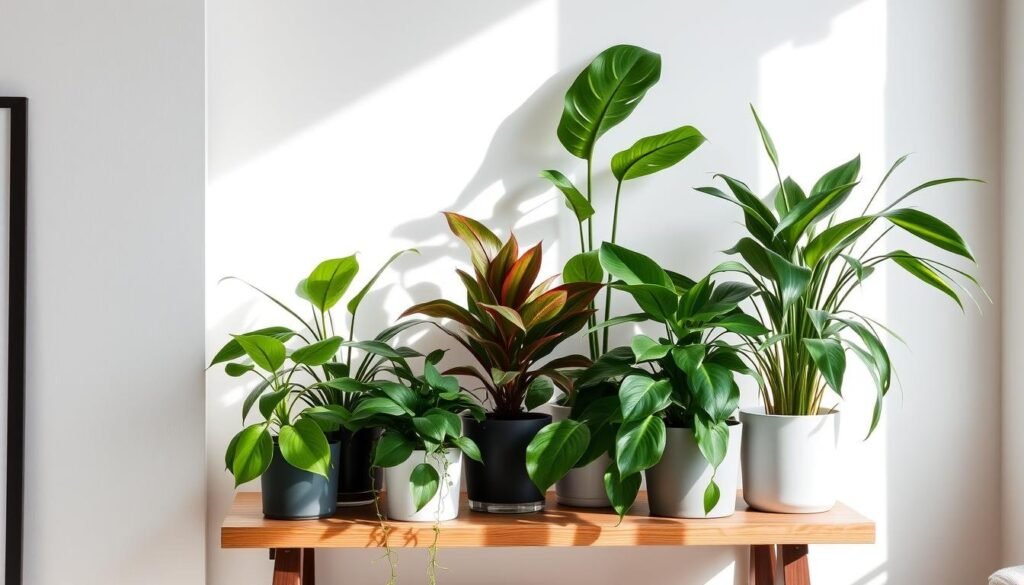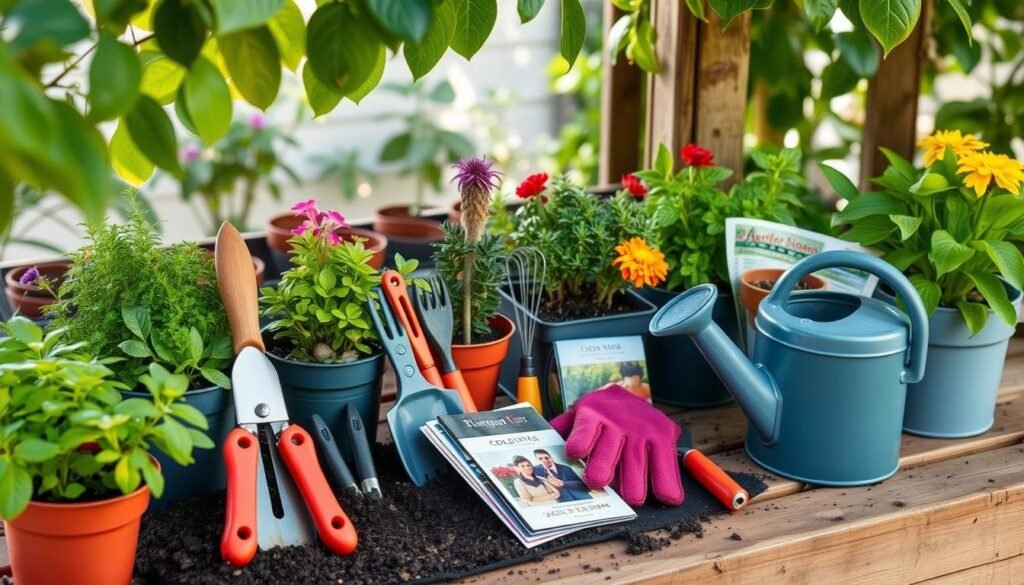Gardening is a fun way to be creative and make your home greener. It’s easy for beginners to start, and it looks great. Plus, it makes you feel connected to nature.
As you start gardening, you’ll find tips to make your space a green oasis. It’s a journey that brings joy and beauty to your home.
Key Takeaways
- Gardening is an accessible hobby for individuals of all skill levels.
- Home gardening can enhance the beauty of living spaces.
- Growing plants offers personal satisfaction and a connection to nature.
- Practical tips can help turn any area into a thriving garden.
- Beginners can learn easily while enjoying the process of plant cultivation.
Understanding the Basics of Gardening
Gardening is about planting, caring for, and harvesting plants. It can happen indoors or outdoors. This makes it easy for beginners to start, helping them connect with nature. Knowing the basics is key for anyone wanting to grow their green thumb.
What is Gardening?
Gardening is growing plants for beauty, food, or to help the environment. Gardeners do many things, like:
- Choosing the right plants
- Preparing the soil
- Planting seeds or seedlings
- Watering and providing care
- Harvesting the produce or flowers
These steps make gardening a rewarding hobby that helps both the environment and the gardener. Learning the basics makes the gardening journey more enjoyable and effective.
The Benefits of Gardening for Beginners
Gardening has many benefits beyond just looking good. It can greatly improve mental health, offering a way to reduce stress and anxiety. People find happiness in caring for their plants, feeling a deep sense of achievement.
It also helps keep you physically active. Gardening involves lots of movement, which is good for your health. Plus, it can bring people together, building stronger community bonds.
In short, gardening makes life better and helps your health and community. As beginners start gardening, they’ll find many rewarding experiences through planting.

Choosing the Right Plants for Your Home
Choosing the right plants is key for new gardeners. Knowing which plants are easy to care for boosts confidence and fun. Here, we focus on the best indoor and outdoor plants for beginners.
Best Indoor Plants for Beginners
Indoor plants are great companions for any home. Here are some easy-to-care-for indoor plants:
- Pothos – It has heart-shaped leaves and does well in low light, needing water only sometimes.
- Snake Plant – This plant is tough and can handle neglect. It works well in different light conditions.
- Peace Lily – It has beautiful white flowers and prefers moderate light. It likes to dry out a bit between waterings.
Easy Outdoor Plants to Start With
Outdoor spaces offer a chance to try easy plants. Here are some reliable options:
- Marigolds – They are bright and cheerful, and they keep pests away.
- Zinnias – They come in many colors and bloom all season long.
- Lavender – It smells great and is good at handling drought once it’s settled.

| Plant Type | Care Level | Light Requirements | Watering Frequency |
|---|---|---|---|
| Pothos | Easy | Low to Bright Indirect | Every 1-2 weeks |
| Snake Plant | Easy | Low to Bright Indirect | Every 2-3 weeks |
| Peace Lily | Easy | Low to Moderate | Weekly |
| Marigolds | Easy | Full Sun | Weekly |
| Zinnias | Easy | Full Sun | Every 1-2 weeks |
| Lavender | Easy | Full Sun | Every 2-3 weeks |
By choosing the right plants, beginners can create a thriving space. Gardening can quickly become a source of joy and pride.
Gardening Tools Every Beginner Needs
For new gardeners, the right tools are key. They make gardening more efficient and enjoyable. Here are the essential tools for beginners.
Essential Tools for Indoor Gardening
Indoor gardening is a fun hobby. The right tools make it easier. Here are the tools every indoor gardener needs:
- Hand Trowel: Great for digging holes or transplanting, it’s easy to use.
- Watering Can: It helps water plants gently, preventing too much water.
- Pruning Scissors: Needed for trimming, they help plants grow well.
- Planters: Different sizes are needed for various plants, giving roots space.
Tools for Outdoor Garden Care
Outdoor gardening needs special tools for tough tasks. Beginners should get these tools:
- Shovel: Essential for digging, it prepares beds and moves soil.
- Hoe: Great for weeding and soil cultivation, it helps plants grow.
- Gloves: Important for protecting hands from soil and thorns, quality gloves are a must.
- Garden Fork: Useful for loosening soil and mixing in compost, it improves soil quality.

Beginners should invest in good gardening tools. The right tools make gardening rewarding. They help grow beautiful plants and give a sense of achievement.
Soil Preparation and Gardening Techniques
Getting your soil ready is key to a great garden. Knowing about different soils and using the right gardening methods can help plants grow well. This part talks about soil types and gives tips for gardening success.
Types of Soil and Their Importance
Knowing the types of soil is crucial for gardeners who want healthy plants. There are mainly three types:
- Sandy Soil: It drains fast but doesn’t hold much water or nutrients.
- Clay Soil: It keeps water well but can get too hard, stopping roots from growing.
- Loamy Soil: It’s a mix of sand, silt, and clay, offering good drainage and nutrients.
Knowing these traits helps in soil preparation and guides in plant care. Adding compost can make soil better for plants, helping them grow stronger.
Basic Gardening Techniques to Consider
Using the right gardening techniques can make gardening better and more rewarding. Here are some techniques to think about:
- Raised Bed Gardening: It helps with drainage and keeps soil warm, great for many plants.
- Companion Planting: Planting certain plants together can help them grow better, keep pests away, and save space.
- Crop Rotation: Moving plants around each season helps keep soil healthy and reduces pests.
By knowing about soil types and using these gardening methods, beginners can do much better in their gardens.
| Soil Type | Characteristics | Best Plants |
|---|---|---|
| Sandy Soil | Quick drainage, low fertility | Cacti, succulents |
| Clay Soil | High water retention, compacted | Hollyhocks, willows |
| Loamy Soil | Balanced moisture, ideal fertility | Tomatoes, peppers, herbs |
Watering and Plant Care Basics
Knowing how to water plants is key to a healthy garden. Each plant has its own needs based on its type, the season, temperature, and humidity. Learning the plant care basics can make your gardening better.
Understanding Plant Watering Needs
Several things affect how often plants need water. Some plants like dry soil, while others need it moist all the time. Knowing your plants’ needs is important.
- Soil Type: Sandy soils drain fast, while clay soils hold water longer.
- Plant Age: Young plants often need more water.
- Environmental Conditions: Hot, windy, or sunny places need more water.
Signs of Over or Underwatering
It’s crucial to know the signs of overwatering and signs of underwatering. Both can harm your plants a lot.
| Condition | Signs |
|---|---|
| Overwatering |
|
| Underwatering |
|
Gardening Hacks for Busy Beginners
Gardening can be a rewarding hobby, but it can be hard to find time for it. Busy beginners can make gardening more fun and less stressful with efficient techniques. Here are some tips and tricks to improve plant health and fit into busy schedules.
Time-Saving Tips for Efficient Gardening
To garden efficiently, planning is key. Here are some tips to save time:
- Create a gardening calendar to track planting, watering, and harvesting schedules.
- Utilize self-watering pots that maintain moisture, reducing daily attention.
- Group plants with similar care requirements together to streamline maintenance tasks.
Unique Tricks for Quick Plant Health Improvement
There are clever gardening hacks to boost plant health easily. Try these:
- Use kitchen scraps such as vegetable peels and coffee grounds to create compost, enriching soil naturally.
- Employ natural pest deterrents, like essential oils or homemade sprays, to keep plants healthy.
Indoor Plants Tips for a Thriving Home Environment
To make your home a cozy space for indoor plants, pay attention to a few key things. Knowing some indoor plants tips can really help them grow well. The right light and the right pot are key to making your plants thrive indoors.
Best Lighting Conditions for Indoor Plants
It’s important to know what light each indoor plant needs. Most plants do best in bright, indirect light. This means they should be near windows but not in direct sunlight, which can burn their leaves. Some plants, like snake plants and pothos, can handle less light, making them perfect for shady spots.
How to Choose the Right Pot for Indoor Plants
Choosing the right pot can be tricky, especially for beginners. But, focusing on size, drainage, and material can really help your plants. The pot should be big enough for the roots but also let air in. It’s also important to have drainage holes to prevent water from causing root rot. Terracotta pots are good because they breathe, while ceramic pots can make your plants look nice.
| Lighting Condition | Best Indoor Plants | Pot Material | Drainage Feature |
|---|---|---|---|
| Bright, Indirect Light | Pothos, Spider Plant | Ceramic, Terracotta | Yes |
| Low Light | Snake Plant, ZZ Plant | Plastic, Metal | Optional |
| Medium Light | Peace Lily, Philodendron | Wood, Clay | Yes |
Outdoor Garden Ideas for Small Spaces
Making the most of small outdoor spaces can spark creativity. Gardeners can turn these areas into vibrant green spots with clever ideas. Vertical gardening and container gardening are two top methods for making the most of space.
Vertical Gardening for Limited Areas
Vertical gardening grows plants up, not out. It’s perfect for small spaces. You can use wall planters, trellises, and hanging pots to support climbing plants.
These plants, like peas and tomatoes, can grow up and save space. They also add beauty to your garden.
Container Gardening: Maximize Your Gardening Space
Container gardening is great for small spaces. It lets you move plants to the best spots. This way, you can grow herbs, flowers, and veggies on balconies or patios.
Containers are versatile, making gardening fun and easy. They open up endless possibilities for creativity and enjoyment.
In summary, vertical and container gardening are creative ways to beautify small outdoor areas. They let people enjoy gardening, even with limited space.
| Gardening Method | Benefits | Best Plants |
|---|---|---|
| Vertical Gardening | Maximizes vertical space, creates a living wall aesthetic | Peas, tomatoes, climbing flowers |
| Container Gardening | Flexible plant placement, easy to move, manageable size | Herbs, pansies, salad greens |
Common Gardening Mistakes to Avoid
Gardening can be very rewarding, but it has its challenges. Knowing common mistakes can help you grow a great garden. Two big mistakes are ignoring pests and not feeding your plants right.
Overlooking Pest Control
Keeping pests away is key to healthy plants. Many new gardeners don’t realize how pests can harm their plants. Watch for signs of pests and act fast.
Using natural helpers like beneficial insects or neem oil can protect your plants. Being careful helps your garden stay healthy.
Neglecting Plant Nutritional Needs
Every plant needs certain nutrients to grow well. Beginners often forget how important fertilizers and soil are. Knowing what your plants need helps you pick the right food for them.
Without the right nutrients, plants won’t grow well. Testing your soil can show what’s missing. This lets you fix your soil and help your plants grow.
| Pest Control Methods | Effectiveness | ease of Use |
|---|---|---|
| Beneficial Insects | High | Moderate |
| Neem Oil | Moderate | Easy |
| Insecticidal Soap | High | Easy |
| Companion Planting | Variable | Moderate |
By knowing these common mistakes, beginners can improve their gardening. Taking care of pests and feeding your plants right makes for a better garden.
Seasonal Gardening Tips for Optimal Growth
Knowing the seasons is key for a great garden. With the right seasonal tips, you can grow your garden well. Each season has its own needs and challenges.
How to Prepare Your Garden for Each Season
Start by understanding seasonal changes. Here’s how to get ready for each season:
- Spring: Improve soil health with compost and drainage. Start with cool-season crops.
- Summer: Mulch to keep moisture in. Water regularly to fight off heat.
- Fall: Pick your crops and get beds ready for winter. Plant cover crops to improve soil.
- Winter: Cover plants from frost. Use this time to plan for spring and gather seeds.
Choosing the Right Time to Plant
Timing is crucial for gardening success. The right planting times can greatly affect plant health and yield. Keep these points in mind:
- Frost dates: Know when the last frost is in spring and the first in fall to avoid damage.
- Plant type: Different plants need different times. Cool-season crops do well in early spring, while warm-season ones thrive later.
- Soil temperature: Seeds germinate better at certain soil temperatures. Make sure the soil is warm enough before planting.
By being aware of seasonal changes and using these tips, gardeners can improve their garden care. Good planning leads to better growth and more harvests.
Conclusion
This guide to gardening tips for beginners is ending, but the basics are key. Learning about plants and soil is crucial. It helps new gardeners grow a beautiful garden.
Trying new things in gardening is exciting. It leads to stunning results and a closer bond with nature. Being patient and consistent is important. This guide helps you enjoy your gardening journey.
Creating a beautiful garden is all about enjoying the process. By using these tips and always learning, you can make your home a green oasis. It will make your space look better and feel more peaceful.
FAQ
What are some gardening tips for beginners?
Start with easy plants like pothos or marigolds. Learn the basics of plant care, like watering and soil types. Use gardening hacks, like grouping plants, to make things easier.
How do I take care of my indoor plants?
Indoor plants need bright, indirect sunlight. Watch their watering needs to avoid harm. Choose a pot with good drainage.
What are the best outdoor garden ideas for small spaces?
Try vertical gardening with trellises or wall planters. It saves space and looks good. Container gardening is also great for small areas, letting you grow many plants and herbs.
What are the basic gardening tools a beginner should have?
You’ll need hand trowels, pruning scissors, a watering can, and gloves. For outdoor gardening, add shovels and hoes. Good tools make gardening better.
How important is soil preparation in gardening?
Soil prep is key for a good garden. Different soils affect growth. Adding organic matter improves soil, helping plants grow well.
What are the common gardening mistakes to avoid?
Don’t forget about pest control and plant nutrition. Check for pests and use fertilizers to keep plants healthy.
What are some seasonal gardening tips for optimal growth?
Each season needs different garden prep, like soil amendment and crop rotation. Plant at the right time for best results. Adjust your garden plan for each season to keep it thriving.
